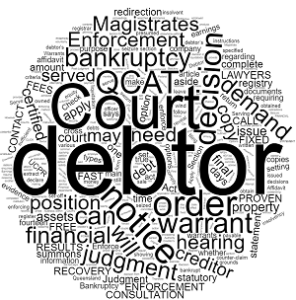Table of Contents
Toggle How do you enforce a QCAT decision?
How do you enforce a QCAT decision?
- First, you must register the QCAT decision in the Magistrates Court; then
- You can enforce it as though it were an order of that Court;
- You can apply for an enforcement warrant, a bankruptcy notice, or serve a statutory demand – to enforce the registered QCAT decision over the property of the judgment debtor.
Stonegate Legal can advise you and assist you with:
- How to register your decision from QCAT (making it an enforceable money order); and
- Tell you about your options for enforcing that Judgment.
If you have been given a decision in QCAT or other tribunal, then you can Enforce a QCAT Decision in the Court with jurisdiction.
The first step in the process in to register your QCAT decision in the Magistrates Court. Once registered it becomes an enforceable money order.
You have done a great job in getting your QCAT Decision. Now let our experienced debt enforcement lawyers enforce that decision for you in the Court, or with a bankruptcy notice, or with a statutory demand
Call 1300 545 133 today and speak to a debt enforcement lawyer
How to Register a QCAT Decision in the Magistrates Court
Section 131 “Monetary decisions” of the QCAT Act says:
(1) This section applies to a final decision of the tribunal in a proceeding that is a monetary decision, to the extent the decision requires payment of an amount to a person.
(2) A person may enforce the final decision by filing a copy of the decision in the registry of a court of competent jurisdiction.
To enforce a QCAT decision therefore, if you have a monetary decision from QCAT, in your favour, and the debtor is still not paying, then you can commence enforcement proceedings by registering the decision in the Magistrates Court.
Once you have a copy of the monetary decision, you will also need to provide the Magistrates Court with an affidavit swearing or affirming that the amount in the monetary decision is still outstanding.
Download Affidavit Template from the Court here – look for form 46 – Affidavit (UCPR)
Once you have your copy and your sworn or affirmed affidavit, you will need to make a couple of copies. Take the original and the copies to the registry of the Magistrates Court and they will stamp the copies with the Court’s seal.
Section 131 “Monetary decisions” of the QCAT Act then goes on to say:
(3) On filing a copy of the final decision under subsection (2) , the decision is taken to be a money order of the court in which it is filed and may be enforced accordingly.
Your Options to Enforce a QCAT Decision
- Enforce the decision in the Magistrates Court;
- Serve the debtor company with a statutory demand; or
- Serve the debtor with a bankruptcy notice.
Enforce a QCAT Decision as a Judgment in the Magistrates Court
Your main options for enforcing the Judgment in the Magistrates Court are:
- Attempt to extract from the debtor information regarding its financial position; or
- Apply to the Court for the issue of one of the various types of enforcement warrant.
Attempting to extract information regarding the debtor’s financial position
This enforcement option is strictly an information gathering exercise. If the debtor provides documents showing any assets they own, the equity in those assets, and details of any debts owed to them, this method of enforcement has achieved its purpose.
Section 807 of the UCPR states:
At any time after a money order is made, an enforcement creditor may, by written notice, require an enforcement debtor to complete and return to the enforcement creditor a statement of financial position of an enforcement debtor in the approved form.
The first step is to give the debtor a written notice requiring them to complete a sworn statement of financial position. They have fourteen (14) days from receiving the notice to complete and return it.
CLICK FOR A FORM 71 STATEMENT OF FINANCIAL POSITION
If you are not satisfied with the contents of the completed statement of financial position, or the debtor does not return one at all, a creditor can then apply to the Court for an enforcement hearing summons order.
Section 808 of the UCPR says:
An enforcement creditor may, without notice to another party, apply to the court, including the court as constituted by a registrar, for an enforcement hearing.
An enforcement hearing summons order is a Court order requiring a debtor to complete a statement of financial position (if they have not done so), produce substantial documents regarding their financial position, and appear in Court for the purpose of being cross examined about their financial position.
The enforcement hearing can proceed no earlier than fourteen (14) days after the enforcement hearing summons order is served.
If a debtor is served with an enforcement hearing summons order at least fourteen (14) days before the date set for the enforcement hearing, but does not attend the hearing, the Court may issue a warrant for their arrest.
Your option to apply to the Court for the issue of one of the various types of enforcement warrant is explained below.
Issuing an Enforcement Warrant
The three (3) main types of enforcement warrants that can be issued by the Magistrate Court to enforce the Judgment are:
- Enforcement warrant for redirection of earnings;
- Enforcement warrant for redirection of a debt; and
- Enforcement warrant for regular redirections from a financial institution.
Enforcement Warrants for Seizure and Sale of Property
To issue a warrant for seizure and sale of property, the Court will need evidence showing what property is owned by this debtor and the equity in that property.
You should perform searches of the online records of the Queensland land titles registry reveal that the debtor owns real property in Queensland.
You can apply for an enforcement warrant requiring the enforcement officer to visit this debtor’s home to make enquiries about whether there are any assets owned by the debtor that can be seized and sold.
However, in our experience, debtors rarely voluntarily reveal to the Court’s enforcement officer what assets they own that can be seized.
Enforcement Warrants for Redirection of Earnings
To issue a warrant for redirection of earnings the Court will need to be provided with evidence:
- whether the enforcement debtor is employed and the enforcement debtor’s employer has been identified;
- whether the enforcement debtor has sufficient means of satisfying the order after deducting;
- the necessary living expenses of the enforcement debtor and the enforcement debtor’s dependants; and
- any other known liabilities of the enforcement debtor.
For the reasons above, we do not recommend applying for an enforcement warrant unless you have sufficient evidence of the criteria mentioned above.
Serving the Debtor with a Bankruptcy Notice
If a debtor owes a judgment debt of over $10,000.00 then a creditor can ask the Federal Circuit Court to declare the debtor bankrupt. To declare this debtor bankrupt the creditor must prove to the Court that debtor has committed an act of bankruptcy.
The most common act of bankruptcy is failing to follow the instructions in a bankruptcy notice as outlined in section 40(1)(g) of the Bankruptcy Act which says:
A debtor commits an act of bankruptcy …
(g) if a creditor who has obtained against the debtor a final judgment or final order, being a judgment or order the execution of which has not been stayed, has served on the debtor in Australia or, by leave of the Court, elsewhere, a bankruptcy notice under this Act and the debtor does not:
(i) where the notice was served in Australia–within the time specified in the notice; or
(ii) where the notice was served elsewhere–within the time fixed for the purpose by the order giving leave to effect the service;
comply with the requirements of the notice or satisfy the Court that he or she has a counter-claim, set-off or cross demand equal to or exceeding the amount of the judgment debt or sum payable under the final order, as the case may be, being a counter-claim, set-off or cross demand that he or she could not have set up in the action or proceeding in which the judgment or order was obtained.
This bankruptcy notice is issued by the Australian Financial Security Authority (the AFSA) and then served on the debtor. The main instruction is that the debtor pay the amount of a judgment debt within the time specified in the bankruptcy notice.
Creditor’s Petition in Bankruptcy
If the debtor fails to follow the instructions in a bankruptcy notice then you can serve a creditor’s petition.
Serving the Debtor with a Post-Judgment Statutory Demand
If the debtor is a company, then you have the option to serve this debtor with a statutory demand for payment of the debt under section 459E of the Corporations Act 2001 (Cth). If the debtor is served with a statutory demand, it will have twenty one days to:
- Comply with the demand; or
- Apply to the Court for an order setting the judgment or the demand aside.
Check out our article on setting aside a stat demand here
If the statutory demand is not set aside and the debtor does not comply with it, then the debtor is presumed to be insolvent for three (3) months. While the debtor is presumed to be insolvent, you may apply to wind it up on the grounds of insolvency.
If the debtor is forced into liquidation, its liquidator(s) will sell all of its assets to raise money in an attempt to make a distribution to its creditors.
The costs of an application to wind up a debtor company on the grounds of insolvency are payable out of the pool of funds realised in the liquidation in priority to the liquidator’s fees.
Conclusion on how to Enforce a QCAT Decision
If you want to enforce a QCAT decision, you first need to register your QCAT decision in the Magistrates Court. Then you need to work out what the best enforcement option would be in your particular circumstances.
CONTACT US FOR A FREE CONSULTATION
Call 1300 545 133 today and speak to a debt enforcement lawyer








